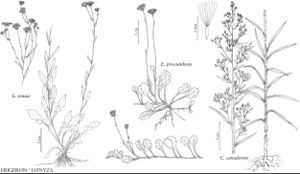Conyza canadensis
Bull. Torrey Bot. Club 70: 632. 1943.
Plants erect, (3–) 50–200 (–350+) cm, branched mostly distally. Leaves: faces usually glabrate (proximal margins ± ciliolate, hairs usually stiff, spreading and hispid on nerves, hairs erect); proximal blades oblanceolate to linear, 20–50 (–100+) × 4–10 (–15+) mm, toothed to entire; distal similar, smaller, entire. Heads usually in paniculiform, sometimes corymbiform arrays. Involucres 3–4 mm. Phyllaries usually glabrous, sometimes sparsely strigose (margins chartaceous to scarious); outer greenish to stramineous, lanceolate to linear, shorter; inner stramineous to reddish, lance-attenuate to linear. Receptacles 1–1.5 (–3) mm diam. in fruit. Pistillate florets 20–30 (–45+); corollas ± equaling or surpassing styles, laminae 0.3–1 mm. Disc-florets 8–30+. Cypselae uniformly pale tan to light gray-brown, 1–1.5 mm, faces sparsely strigillose; pappi of 15–25, white bristles 2–3 mm. 2n = 18.
Phenology: Flowering year round, mostly summer–fall.
Habitat: Disturbed places
Elevation: 0–2000 m
Distribution

Alta., B.C., Man., N.S., Ont., P.E.I., Que., Sask., Ala., Ariz., Ark., Calif., Colo., Conn., Fla., Ga., Idaho, Ill., Ind., Iowa, Kans., Ky., La., Maine, Md., Mass., Mich., Minn., Miss., Mo., Mont., Nebr., Nev., N.H., N.J., N.Mex., N.Y., N.C., N.Dak., Ohio, Okla., Oreg., Pa., R.I., S.C., S.Dak., Tex., Utah, Vt., Va., Wash., W.Va., Wis., Wyo., Mexico, Central America, in South America, Europe, Asia, Africa
Discussion
Conyza canadensis is thought to be native to North America and is now widely adventive, e.g., in South America, Europe, Asia, and Africa. Plants with stems glabrous and phyllaries red-tipped are sometimes treated as var. pusilla; similar plants with stems glabrous and phyllaries stramineous (not red-tipped) are sometimes treated as var. glabrata.
Selected References
None.
